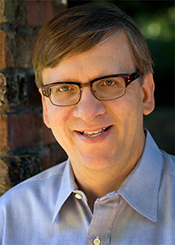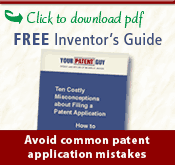Ask YourPatentGuy…
Here are the top 10 questions inventors often ask. For more in-depth information, download Michael’s free Inventor’s Guide.
1. What is a patent?
A patent is a government-granted right that enables you to exclude someone else from making, using, selling, offering for sale or importing the invention covered by a valid claim of your patent.
2. What can be patented?
According to the patent statute, any person who “invents or discovers any new and useful process, machine, manufacture or composition of matter, or any new and useful improvement thereof, may obtain a patent,” subject to the conditions and requirements of the law. A complete description of the actual machine or other matter for which a patent is sought must be submitted with the application.
3. Are there different types of patents?
Yes. The three most common types of patents are:
- utility patent — protects the structure, operation or composition of a machine or process, or improvements to a machine or process
- design patent — protects nonfunctional, ornamental features of a new article of manufacture
- plant patent — awarded to someone who has invented or discovered, and asexually reproduced, any distinct and new variety of plant
4. How do I obtain a patent?
The process begins by filing and successfully prosecuting a patent application so at least one allowed claim is present. The application is written according to the type of invention and scope of protection desired. It is then submitted to the United States Patent and Trademark Office along with the appropriate fees. The Patent Office confirms that basic filing requirements are met and assigns an Application Number before routing the application to an Art Unit.
5. What does a patent application consist of?
A patent application is a prose narrative written specifically for the invention for which you seek protection. A patent application for a design application is a short document showing a series of different views of the invention and a description of the contents of those views. A patent application for a plant patent includes the same components as other applications.
6. What is the difference between a trademark and a patent? A copyright and a patent?
A trademark or a service mark is anything used to identify the source, origin or quality of a product or service. The mark may be used only by its owner or authorized licensee. A trademark or service mark does not prevent others from making or selling the same goods or services under different trademarks or service marks.
A copyright is a form of protection provided to authors of “original works of authorship” including literary, dramatic, artistic and certain other intellectual works, both published and unpublished. Copyrights are registered by the Copyright Office of the Library of Congress. Trademarks and service marks are issued by the United States Patent and Trademark Office.
7. Why should I hire a registered patent attorney?
By working with a registered patent attorney you are safeguarded in two ways. You’ll have an attorney who is registered with the U.S. Patent & Trademark Office and is a member of the California State Bar. If you work with someone who is not registered you will not be protected by patent law statutes concerning ethical conduct or, in the case of a registered patent attorney, State Bar ethical conduct rules. Furthermore, you cannot be certain that your helper is qualified to protect inventions. The patent laws and regulations change frequently, as do current best practices. That’s why it’s important to hire someone who routinely prepares and files patent applications.
8. Is a patent search always necessary?
No. A patent search is useful to guide the scope of the patent claims and in some cases to help a patent Examiner during examination of a patent application. A patent search is typically done only among U.S. Patents and pre-grant publications. Usually there is little to be gained from a patent search in technology areas where innovations occur rapidly. For mature technologies, e.g. golfing, bicycling, cooking apparatus and simple mechanical inventions, patent searches are usually recommended.
9. Does owning a patent guarantee that my idea won’t be copied?
Unfortunately, no. Since it is not a crime to infringe a patent in the U.S., there is no governmental agency to enforce the rights of patent owners. That’s why most patent holders hire a patent attorney to perform infringement analyses and issue notice letters to warn potential infringers. Worst case scenario: you may have to file a lawsuit in federal district court to stop an infringer.
10. How long does it take to get a patent?
It is not uncommon for it to take up to three or more years before the USPTO issues a patent, and during this time an inventor has no enforceable rights. However, the USPTO has recently proposed new rules to expedite certain patent applications and determine patentability within one year. To be eligible for “accelerated examination,” applicants will be required to provide specific information so that review of the application can be completed rapidly and accurately.
Get more detailed answers to these and other important questions in Michael’s free Inventor’s Guide.







